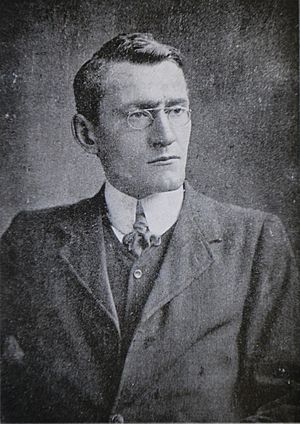Richard Hayes (politician) facts for kids
Quick facts for kids
Richard Hayes
|
|
|---|---|
 |
|
| Teachta Dála | |
| In office August 1923 – January 1924 |
|
| Constituency | Limerick |
| In office May 1921 – August 1923 |
|
| Constituency | Limerick City–Limerick East |
| In office December 1918 – May 1921 |
|
| Constituency | Limerick East |
| Personal details | |
| Born | 1882 |
| Died | 16 June 1958 (aged 75–76) Dublin, Ireland |
| Nationality | Irish |
| Political party | Cumann na nGaedheal |
| Other political affiliations |
Sinn Féin |
| Spouse | Hilda Shaw |
Richard Francis Hayes (1882 – 16 June 1958) was an important Irish person. He was a politician, a historian, and a medical doctor. He played a part in Ireland's fight for independence.
Contents
Richard Hayes: A Life of Service
Richard Hayes was born in 1882. He was a volunteer in the Easter Rising in 1916. This was a major event in Ireland's history. He was involved in fighting near Garristown and Ashbourne.
Early Political Career
In 1918, he was elected as a Sinn Féin politician. He represented East Limerick. At this time, Ireland was still part of the United Kingdom.
In January 1919, many Irish politicians decided not to go to the British Parliament. Instead, they met in Dublin. They formed their own parliament called Dáil Éireann. This was a big step towards Irish independence. Richard Hayes was elected to this Dáil. However, he could not attend at first. He was imprisoned by the British authorities.
During the War of Independence
During the Irish War of Independence, Richard Hayes was held in the Curragh Camp. This was a place where people were kept without trial. He was elected again in 1921. This time he was a Teachta Dála (TD) for Limerick City–Limerick East. A TD is a member of the Irish parliament. He was released after a truce was agreed.
He supported the Anglo-Irish Treaty. This treaty created the Irish Free State. He voted in favor of it. He was re-elected in 1922 as a pro-Treaty Sinn Féin TD. Later, he became a TD for the Cumann na nGaedheal party. This was in the 1923 general election.
Life After Politics
Richard Hayes left politics in January 1924. He then took on other important roles. From 1941 to 1954, he was the Irish Film Censor. This meant he decided what films could be shown in Ireland. He also became a director of the famous Abbey Theatre.
A Respected Historian
Richard Hayes was also a leading historian. He was an expert on Ireland's connections with France. He studied these links from the 1600s to the 1800s. He wrote several important history books.
One of his books was The Last Invasion of Ireland: When Connacht Rose (1937). This book was special because it used stories passed down by people. It also used official records. Other books he wrote include Ireland and Irishmen in the French Revolution (1932). He also wrote Irish Swordsmen of France (1934). His book Biographical Dictionary of Irishmen in France (1949) was also very important. For his work on Irish soldiers in France, he received a special French award. It was called the Légion d'honneur.
A Caring Doctor
Richard Hayes was known as a hard-working and well-liked doctor. He was a good friend to the writer Frank O'Connor. Richard Hayes helped Frank O'Connor with his book. The book was called The Big Fellow. It was about the Irish leader Michael Collins.
Richard Hayes is buried in Deansgrange Cemetery.

